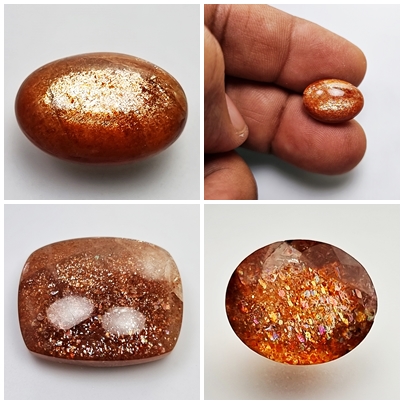Sunstone: Gemstone Information
Sunstone, a captivating gemstone known for its warm, golden hues and shimmering optical effects, has garnered attention not only for its aesthetic appeal but also for its perceived metaphysical properties and potential health benefits. This variety of feldspar, primarily composed of oligoclase, holds geological, historical, and cultural significance, making it a sought-after gemstone in the world of jewelry and holistic practices.
Geological Origin:
Sunstone forms in various geological settings, primarily within igneous rocks such as granites and pegmatites. Its shimmering effect, known as aventurescence, arises from tiny plate-like inclusions of hematite or goethite that reflect light, giving the gemstone its characteristic sparkle. Significant deposits of sunstone have been found in countries such as the United States (Oregon), Norway, Russia, India, and Tanzania.
Physical Properties:
Sunstone typically exhibits translucent to transparent qualities with a vitreous luster. Its colors range from golden, orange, and red to brown, with occasional hints of green or blue. The presence of copper or hematite inclusions contributes to its unique optical effects. Sunstone has a hardness ranging from 6 to 6.5 on the Mohs scale, making it suitable for use in jewelry.
Historical Significance:
Sunstone has a rich historical legacy, with evidence of its use dating back centuries. Ancient civilizations revered sunstone for its perceived connection to solar energy and vitality. In Norse mythology, sunstone was believed to possess the power to navigate the seas even in cloudy or stormy weather. Historical accounts suggest that Vikings may have used sunstone as a navigational aid to locate the sun’s position on overcast days.
Cultural Significance:
Sunstone holds cultural significance in various traditions and belief systems worldwide. In addition to its association with solar energy and light, sunstone is often regarded as a symbol of abundance, vitality, and empowerment. It is believed to radiate positive energy and foster optimism, creativity, and motivation. Some cultures also attribute sunstone with healing properties, promoting physical vitality and emotional well-being.
Metaphysical Properties:
In metaphysical and holistic practices, sunstone is associated with several beneficial properties. It is believed to stimulate the sacral chakra, enhancing creativity, passion, and sensuality. Sunstone is also thought to promote self-confidence, leadership, and optimism, making it a popular choice for individuals seeking to overcome self-doubt or negativity. Additionally, sunstone is often used for meditation and spiritual growth, facilitating inner strength and resilience.
Health Benefits:
While scientific evidence supporting the health benefits of sunstone is limited, some practitioners believe that wearing or carrying sunstone can have positive effects on physical and emotional well-being. It is thought to boost energy levels, alleviate stress, and improve mood, promoting a sense of vitality and vitality. Sunstone is also believed to aid in digestion and metabolism, supporting overall health and vitality.
Jewelry and Decorative Use:
Sunstone’s vibrant colors and unique optical effects make it a popular choice for jewelry and decorative pieces. It is often faceted into gemstones for use in rings, pendants, earrings, and bracelets. Sunstone beads are also commonly used in beaded jewelry designs. Additionally, sunstone rough and cabochons are prized by lapidaries for creating ornamental objects such as sculptures, carvings, and figurines.
Conclusion:
Sunstone’s mesmerizing appearance and perceived metaphysical properties have made it a beloved gemstone in the world of jewelry and holistic practices. Whether admired for its shimmering optical effects, cultural symbolism, or potential health benefits, sunstone continues to captivate enthusiasts and spiritual seekers alike. As with any gemstone, individual experiences and beliefs may vary, but the allure of sunstone remains undeniably radiant.





